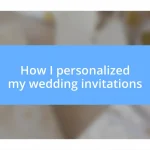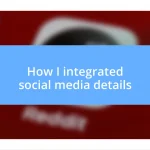Key takeaways:
- RSVP links simplify event planning by providing convenience, customization, and engagement, reducing the need for follow-ups and enhancing the guest experience.
- Best practices include ensuring clarity and mobile-friendliness, sending timely reminders, and personalizing communication to foster a connection with guests.
- Analyzing RSVP link performance, such as response rates and feedback, helps improve future events and strengthens relationships with attendees.

Understanding RSVP links
RSVP links are a vital tool for managing event attendance effectively. From my experience, they simplify the process for both the host and the guests. Isn’t it reassuring to have a click-to-confirm option rather than endless phone calls?
I remember organizing a birthday party a while back, and using an RSVP link was a game-changer. Instead of keeping track of who said they would come and who might be a no-show, I could simply check the online responses. It felt much more streamlined and less stressful; I could focus on the fun aspects of planning!
These links provide instant clarity, allowing you to see who has confirmed and who hasn’t. I often find myself wondering, is there a better way to engage guests? With RSVP links, I’ve been able to foster that connection effortlessly, ensuring everyone feels acknowledged and excited to attend.

Benefits of using RSVP links
The use of RSVP links brings undeniable convenience to the event-planning process. From my personal experience, nothing beats the ease of an automated system that collects responses in one place. Once, while planning a wedding, I felt an enormous weight lifted off my shoulders. I didn’t have to chase after guests or play guessing games about attendance. Instead, I could see the numbers at a glance, allowing me to make decisions confidently.
Another significant benefit is the ability to customize your RSVP experience. You can ask specific questions regarding meal preferences, plus-ones, or attendance confirmation—all directly on the RSVP page. When I invited friends over for a dinner party, I included a quick question about dietary restrictions. The responses helped me tailor the menu perfectly, making sure each guest felt considered and comfortable.
Finally, using RSVP links amplifies engagement with your guests. Each time they interact with the link, it fosters a sense of anticipation. I noticed this firsthand when I sent out event links for a reunion. Many friends mentioned how fun it was to click through and select their preferences. It’s a small gesture, but it builds excitement and encourages a positive atmosphere leading right up to the event.
| Benefits | My Personal Insights |
|---|---|
| Convenience | Effortlessly tracks responses without continual follow-up. |
| Customization | Ensures guests feel considered with tailored questions. |
| Engagement | Increases excitement and anticipation for the event. |

How to create RSVP links
Creating RSVP links is a straightforward process that can significantly enhance your event planning experience. I’ve found the most effective way is to use online platforms specifically designed for this purpose. They often provide user-friendly interfaces that allow you to customize your links to match your event’s theme. I remember experimenting with different link formats when I planned a surprise party for a friend—it added a fun touch when guests could view the theme before responding.
Here’s a quick guide on how to create RSVP links:
- Choose a Platform: Select a service like Eventbrite, Google Forms, or a dedicated event management tool.
- Customize Your Link: Edit the link’s appearance to reflect your event’s style; it makes it more inviting.
- Ask Relevant Questions: Include essential questions about attendance, meal preferences, or special requests.
- Share the Link: Send it through email or social media, and make sure it’s easily accessible!
When I first attempted to create an RSVP link for my family gathering, I was pleasantly surprised by how simple it turned out to be. I was able to gather responses from ten different relatives without picking up the phone once! Seeing their confirmations pop up felt like a mini-celebration in itself, making me even more excited for the event.

Best practices for RSVP links
When it comes to RSVP links, clarity is key. I always make sure that the invitation and the link itself are easy to understand. For instance, during my friend’s birthday party, I noticed that some guests missed essential details because the RSVP link wasn’t highlighted. I learned that using bold text or a distinct color can guide guests to the information they need. It’s all about making their experience seamless.
Additionally, I’ve found that timing plays a significant role in how effectively RSVP links engage guests. Sending the link too early might mean it gets lost in their inbox, while waiting too long can lead to last-minute chaos. I remember planning a picnic and sending out the RSVP a month in advance, then sending a gentle reminder a week later. This approach kept everyone informed and excited without feeling rushed.
Another best practice is to ensure that the RSVP process is mobile-friendly. Many of us are glued to our phones! I realized this when I sent out a link that wasn’t optimizing for mobile devices. Some guests struggled to respond while on the go, and I nearly missed important confirmations. Making sure that the RSVP link can be accessed easily from any device keeps the engagement levels high and ensures that no one misses the chance to respond.

Tracking guest responses effectively
One effective way I’ve tracked guest responses is by setting clear deadlines for RSVPs. I once hosted a dinner party and requested everyone to respond by a specific date. This not only created a sense of urgency but also helped me finalize the menu without feeling rushed. Do you see how easy it is to maintain control over your guest list when everyone knows when they need to respond?
Using spreadsheets to compile responses has been a game changer for me. For a recent outdoor gathering, I created a simple Google Sheet to record each guest’s status. The satisfaction of watching the cells fill up with “Yes” or “No” was gratifying. It’s more than just tracking; it’s about visually capturing the anticipation and ensuring that nobody is left out of the fun!
I also learned the importance of following up personally with unresponsive guests. Recently, I noticed a few friends hadn’t replied to my RSVP link for an upcoming event. A quick message or call not only reassured them of their welcome but also brought about heartfelt conversations that made the planning process feel more personal. Isn’t it amazing how a little follow-up can transform a simple event into an occasion that resonates deeply with everyone involved?

Enhancing guest engagement strategies
One of the strategies I’ve embraced to enhance guest engagement is personalizing the communication surrounding the RSVP link. Recently, I included a short, heartfelt message in my RSVP invitation for a family reunion. I noticed that when I expressed how excited I was to see everyone, it sparked that same enthusiasm in my guests. It made me wonder, how much more connected do people feel when they know you genuinely care about their presence?
Moreover, incorporating interactive elements can significantly elevate the experience. During a recent garden party, I added a fun poll within the RSVP link where guests could vote on their favorite snacks. Not only did this indicate what to prepare, but it also turned the RSVP process into an engaging activity. I couldn’t believe how many guests responded enthusiastically, sharing their culinary favorites. Isn’t it fascinating how a little creativity can transform a mundane task into a delightful interaction?
Lastly, I’ve found that providing updates about the event after RSVPs come in keeps the momentum going. After my last birthday event, I shared sneak peeks of the décor and menu with those who RSVP’d. The feedback was exceptional! It felt like we were building a community around the event, which profoundly enhanced their anticipation. Have you ever thought about how sharing behind-the-scenes moments can turn your event into a shared experience, even before it begins?

Analyzing RSVP link performance
When analyzing the performance of RSVP links, I’ve learned that data is key. I often check the response rates not just for numbers, but to gauge interest. For instance, after inviting close friends to a casual barbecue, I noticed that the RSVP link received a quick burst of “Yes” replies within the first few days. But then, it slowed down. This dip made me curious—were they genuinely busy or hesitant about attending?
Tracking the click-through rates on invitations is another factor I can’t overlook. After one event, I discovered that a significant number of guests opened the RSVP link but didn’t complete it. I wondered what might be holding them back. Was the process too complicated? Or was it perhaps an oversight? This realization prompted me to streamline future links, making them more user-friendly, which ultimately led to higher engagement in my next gathering.
Finally, reflecting on the comments I received with the RSVPs has been invaluable. I recall a recent dinner where several guests left feedback about dietary restrictions and preferences. This input didn’t just help me plan better; it made everyone feel heard and valued. Have you ever noticed how a simple acknowledgment can foster deeper connections? By analyzing these responses, I’ve transformed RSVP data into a foundation for stronger relationships.














